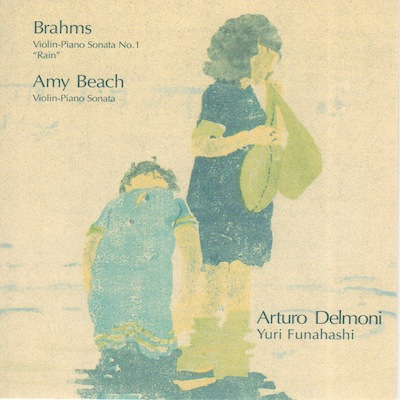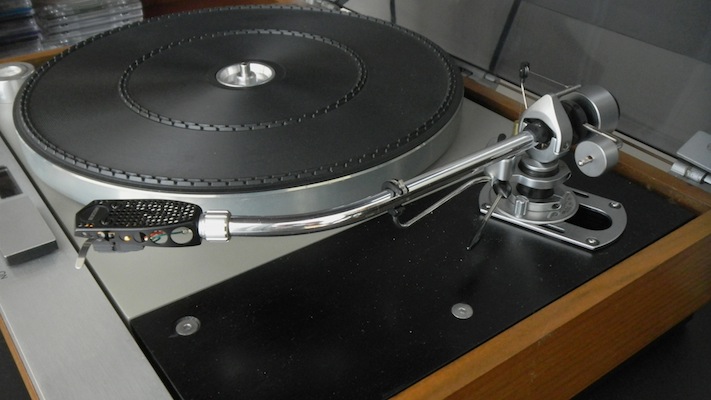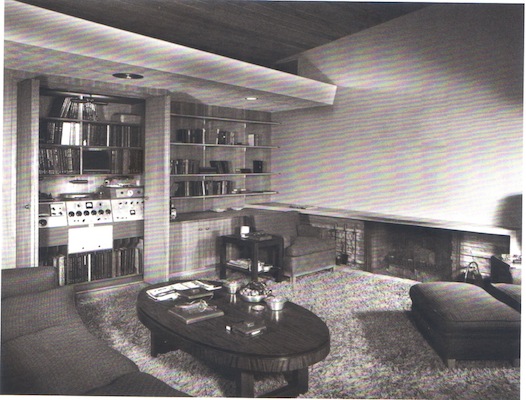
Jennifer Warnes: “Song of Bernadette”
Gustav Mahler and his wife Alma (née Schindler) had a marriage that was often troubled. Mahler started out on the wrong foot by insisting that his musically-talented (and, much younger) fiancée renounce her own ambitions to write serious music. (Alma had already composed some songs, and had worked on some instrumental music, as well as an opera sketch). Years later, a hammer-blow of fate befell Gustav and Alma with the death of their five-year old daughter Maria Anna. That shock was followed by the hammer-blow of Gustav’s diagnosis with the heart defect that eventually caused his early death.
Mahler only later discovered that, reeling from her daughter’s death (and, doubtless, also reeling from Mahler’s determination to isolate himself, so he could put on paper all the music that was within him, before it was too late), Alma had taken up romantically (and sexually) with a young architecture student named Walter Gropius.
For what all of that has to do with Jennifer Warnes, you will have to clink on the jump link to find out. Continue Reading →
Arturo Delmoni & Yuri Funahashi: Amy Beach Violin Sonata (complete performance)

Tuesday, September 5, 2017 is the 150th anniversary of the birth of Amy Marcy Cheney Beach (September 5, 1867 – December 27, 1944). To quote Wiki: “She was the first successful American female composer of large-scale art music, breaking a glass ceiling when her ‘Gaelic’ Symphony was performed by the Boston Symphony Orchestra in 1896.”
Arturo Delmoni asked me to upload not just sound bites but instead his and Yuri Funahashi’s entire recorded performance (from CD JMR 2, which a third-party seller on Amazon would like you to pay $1,526.83 for a new copy of—but there is a bottom-feeding underbidder asking only $166.99; such are the values of my back catalog on the crazy collector market).
After the jump there are: a photo of Mrs. H.H.A. Beach (as she wished to be known); m4a embeds of all four movements of her Sonata in A minor, Op. 34; and the relevant section of my liner-note essay.
Happy Birthday, Mrs. Beach!
Playing J.S. Bach in the Style of Nicholas Bruhns
My musically-astute friend and I had a wonderful time attending the lectures, discussion panels, recitals, and concert performances of this year’s Bard Festival. Each year, the Bard Festival focuses on one composer; this year’s model was Chopin. Of course, such a project also examines Chopin’s milieu and his formative experiences, his personal life (I learned a lot about George Sand), and his musical influences and musical contemporaries. Next year’s Festival is all about Rimsky-Korsakov and His World; it gets my highest recommendation for an in-depth, challenging, and rewarding cultural experience, all in a wonderful setting near the Hudson River.
Bard College, by the way, is where future rock band Steely Dan‘s co-founders Becker and Fagan met; I was bold enough to ask a Bard administrator where I could find the shrine to Steely Dan, and he smiled at me indulgently. By the way, a Bard-era, pre-Steely-Dan, Becker-and-Fagan group included future comedian Chevy Chase, on drums… . Continue Reading →
Vintage SME 3009 Tone Arm Rebuild, Part 1

My music-loving friend who upgraded his Bricasti M1 to the gold-plated edition wanted to be able to continue to listen to Long-Playing vinyl phonograph records. However, while Bricasti’s M12 Source Controller does have a set of analog inputs, the M1 does not.
I suppose I should now insert a Heresy Trigger Warning Alert, in that I believe that in most cases, LPs are not really a high-resolution format–compared to anything as good as or better than native 20-bit 44.1kHz PCM. So I chose the expedient but gratifyingly effective path of specifying an affordable Analog to Digital Converter that I surmise was made for the Custom Installation market, the now-discontinued Key Digital AXXDA, for the princely sum of $50. That unit is based on a 24-bit, 48kHz chip.
Click on the jump link to hear the surprisingly good results from a MoFi vintage Frank Sinatra 180-gram remastering! Continue Reading →
John Coltrane’s “Giant Steps,” Animated Representation
John Coltrane would leave for a road trip with the Quartet carrying nothing but his horn case and the Slonimsky book.
—McCoy Tyner
John Coltrane (1926-1967) is generally recognized as one of the most significant saxophonists in music history. However, at times I wonder whether the famous phrase applied to his playing—”Sheets of sound”—actually might lead the unwary to underestimate his talent, work ethic, and achievements. Such is the problem with music-history courses graded via multiple-choice examinations. “Coltrane???” “Oh, yeah—Sheets of sound!” A bit reductive… .
In truth, Coltrane was quite a Music Theory Nerd. He owned a copy of Nicholas Slonimsky’s fearsome Thesaurus of Scales and Melodic Patterns, and had memorized much of it. (That book, first published in 1947, includes more than a thousand musical examples, the majority being not in traditional Western major or minor scales.)
The title track of Coltrane’s LP Giant Steps (recorded 1959) moves through three keys separated by major thirds… hence the giant steps. The tight structuring of this brief musical gem should dispel the impression that Coltrane was just making random noises. The animated graphical representation by Michal Levy is in its own way a great work of art, too.
# # #
John McLaughlin and the “Tonight Show” Big Band: “Cherokee” (1986)
There’s not too much to say about this… the music so confidently speaks for itself.
I first became aware of John McLaughlin upon seeing and hearing his third solo album My Goal’s Beyond. Woober Joobers. I had never heard an Ovation “Roundback” guitar before; and the fact that the original LP album cover showed McLaughlin’s meditation room (and a portrait of his guru, Sri Chinmoy), intrigued me.
Years later, attending Vanderbilt Law School, at an overstock sale at the University bookstore, I bought a book of Meditations by Sri Chinmoy; and: it cut me to the quick.
Quoting from memory: Chinmoy stated that Jesus knew in advance and even predicted that Peter would deny him three times.
But: Chinmoy goes on to say, Jesus chose no one else as the Rock upon whom He would found his church. Continue Reading →
Frank Sinatra’s Hi-Fi, circa 1947
 Photographed in 1949 by Julius Shulman.
Photographed in 1949 by Julius Shulman.
Julius Shulman: Modernism Rediscovered (3 vols.)
Directed and Produced by Benedikt Taschen
Taschen, Cologne, 2016
Vol. 1: 336 pp.; 15.5 x 10.5 x 1.5 inches; 19 pounds total weight for set.
Frank Sinatra signed with Colombia Records in 1943. However, wartime rationing meant that only the so-called “V-Discs” (“Victory Discs”) that were recorded as morale boosters for service personnel overseas could be manufactured. Regular commercial recording resumed only after the end of the war. The Voice of Frank Sinatra, Sinatra’s first “album” of four 78rpm records, was released in March 1946, having been recorded in two sessions on July 30 (Hollywood) and December 7 (New York) 1945. The Voice of Frank Sinatra went to the top of the Billboard chart, and stayed at No. 1 for seven weeks.
Ironically enough, though, it was Sinatra’s contract with movie studio MGM that provided him his first million dollars, enabling him in 1947 to hire architect E. Stewart Williams. At first, Sinatra had wanted a Georgian mansion, complete with brick façade and white columns. But Williams was able to convince Sinatra that the Palm Springs location called for a different style. As you can see above, when originally built, the Sinatra House housed a state-of-the-art 78rpm hi-fi system. Continue Reading →
Joel Fredericksen and Ensemble Phoenix Munich: “Requiem for a Pink Moon”
 Photo Thomas Zwillinger, courtesy of Harmonia Mundi.
Photo Thomas Zwillinger, courtesy of Harmonia Mundi.
Joel Fredericksen and Ensemble Phoenix Munich: Requiem for a Pink Moon
CD Harmonia Mundi HMC 902111 (recorded 2012)
(No high-resolution download available, apparently.)
Joel Fredericksen, bass voice and lute; Timothy Leigh Evans, tenor voice and drum; Domen Marincic, viola da gamba; Axel Wolf, theorbo and archlute; producer and engineer not credited.
Back in December, in my coverage of the Wilson Audio/MSB event at Fidelis AV in New Hampshire, I mentioned how the late-stayers were moved by the cuts I played from Joel Fredericksen and Ensemble Phoenix Munich’s Elizabethan Nick Drake tribute Requiem for a Pink Moon. You could have heard a pin drop. If that album is unknown to you, here’s a brief précis:
The idea of classical bass singer Joel Frederiksen and Ensemble Phoenix Munich’s putting together an early-instruments Elizabethan tribute album to Nick Drake might strike you as daft, as it did me. But, it works. It’s the real deal. There was a melancholic plaintiveness to Drake’s music that is not at all far from the Elizabethan temperament. Frederiksen of course sings both beautifully and un-selfconsciously. But what makes this recording one of the most affecting I have heard in years is that the interleaving of Elizabethan laments and parts of a Gregorian Chant Requiem Mass with Drake’s songs makes such a powerful connection to the universal human experiences of loss and grief, and not just to one particular artist or album. Buy one for yourself, and buy several to give as gifts.
Sir Colin Davis: “Nimrod” from “Enigma Variations” (Elgar)
I am working on reviews of new-ish recordings of Edward Elgar’s two published symphonies, so, this video of Sir Colin Davis with an unidentified orchestra playing the slow variation from the “Enigma” Variations is timely. (My guess as to the identity of the orchestra is that it is the City of Birmingham Symphony Orchestra, judging by the façade pipes of the organ. I also deduce that the movement was played as an encore… .) I was privileged to hear Davis conduct Elgar’s masterpiece The Dream of Gerontius twice, twenty-five years apart, with the Boston Symphony Orchestra. There is no question that Davis was one of the most important Elgar conductors of the modern era. His live “Enigma” Variations recording with the London Symphony is available on SACD for only $14.99; the CD is $9.99. The “Enigma” Variations is one of those pieces that should be part of everyone’s cultural awareness.
# # #
Audio-Technica ATH-M50x Headphones

Berlin the Bear says, “Body-Shaking Bass!!!”
This is the sixth (and final) installment in my series about choosing Pareto-Optimal equipment to make archival digital copies of vinyl LP (long-playing) phonograph records. The first part (an overview) is here. Part 2 (Rega’s Planar 3 turntable package) is here. Part 3 (Graham Slee’s Revelation M phono stage) is here. Part 4 (a USB computer interface to handle analog-to-digital conversion) is here. Part 5 (software to make and edit a digital transfer of an analog LP) is here. This installment is about choosing headphones and monitoring loudspeakers for digitizing legacy media formats.
In much the same way that one cannot go wrong buying paint from Benjamin Moore (there probably are “better” paints; but, for most people and most uses, Benjamin Moore is the Pareto-Optimal choice), one cannot go wrong buying Audio-Technica’s ATH-M50x headphones. Their virtues include (as far as I know) class-leading sound in their very affordable price tier (in Basic Black, $149 with free shipping from B&H Photo); closed-back earcup design for two-way sound isolation; comfort; and robust construction.
Part of my calculus is that for the limited purposes of ripping and editing an LP, headphones (or monitoring loudspeakers) that are good enough, will be good enough. For an elaboration of that, and other headphone options and loudspeaker options, please click on the jump link. Continue Reading →


